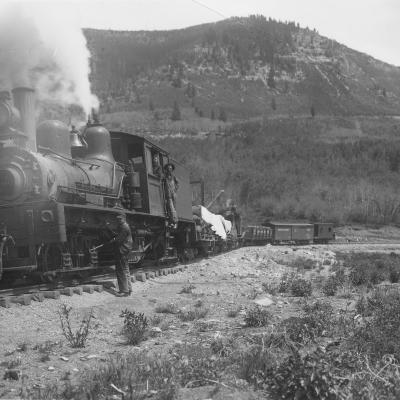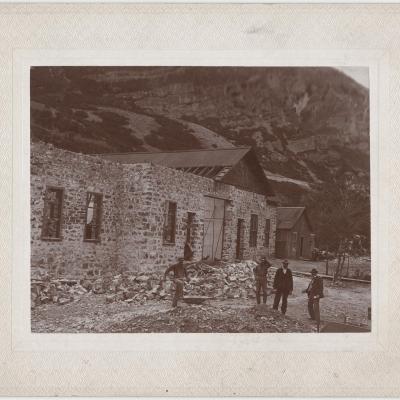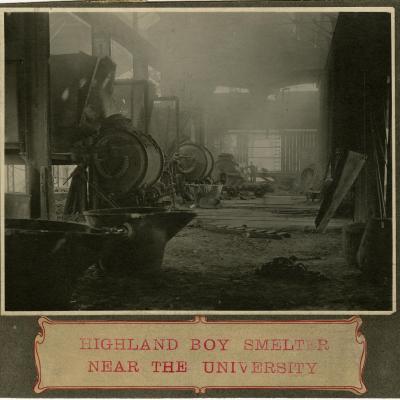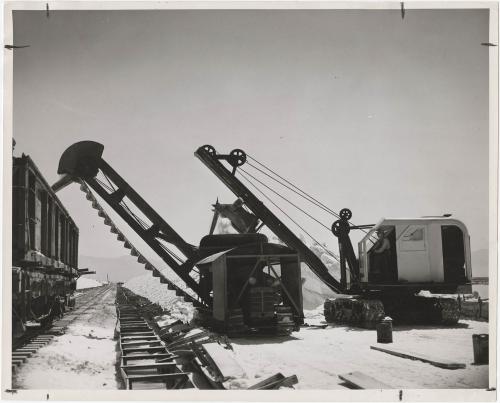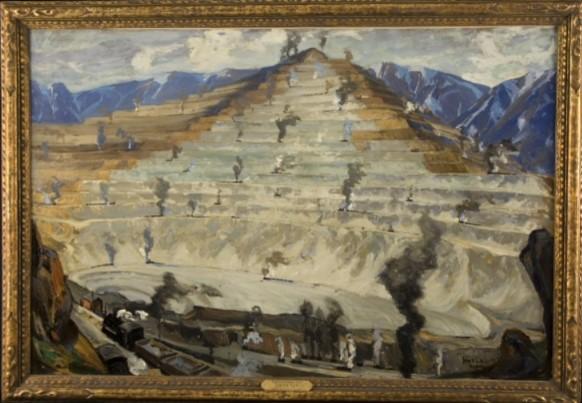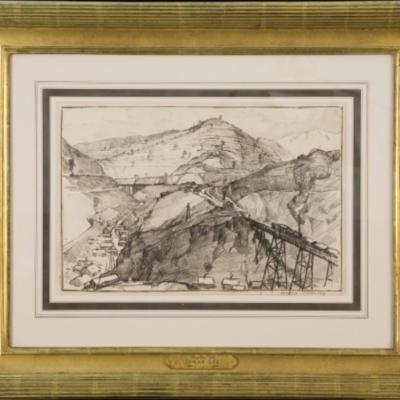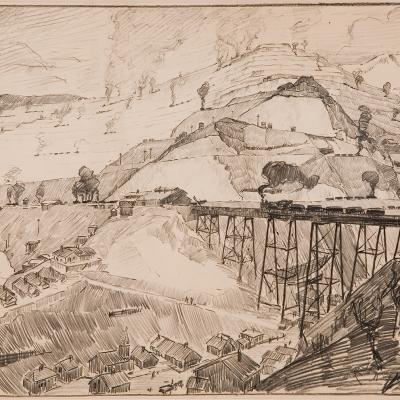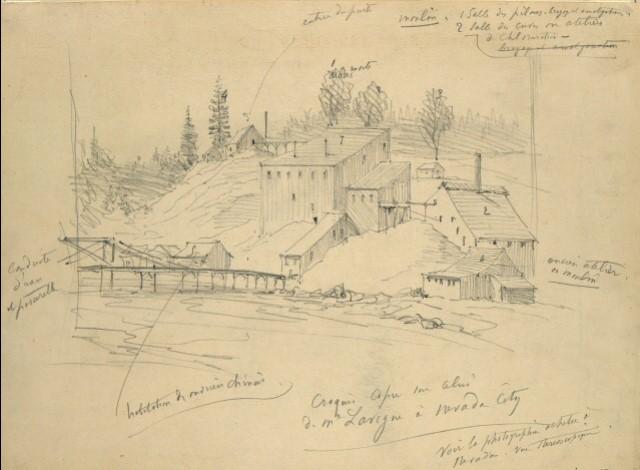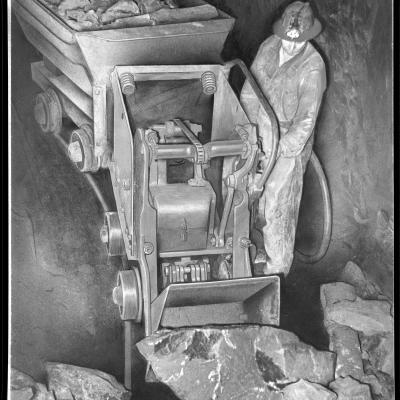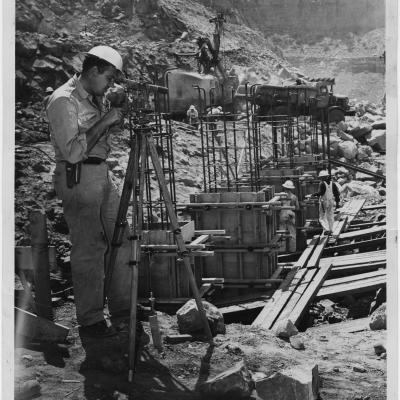Industry Economic Human Landscape
Technology
In Special Collections
At the Utah Museum of Fine Arts
Related Resources
In Special Collections
The promise of wealth drove technological innovations at a rapid pace. Cutting edge methods were no sooner implemented than they were supplanted by more powerful and efficient models. Completed in 1898, Nunn’s Power Station (“the first high-voltage, long-distance, alternating power transmission system in the world”) supplied power to mines 32 miles away in Mercur. Just six years later, the facility was moved downstream to a site where it could harness even greater power. Similarly, in 1926, an innovative locomotive was designed to navigate the steep elevations and extreme curves of the narrow gauge track of the Uintah Railway, which transported gilsonite to a junction with the Denver Rio Grande Railroad. The railway and locomotive were supplanted by cheaper truck transport in 1939. The locomotives were sold and subsequently scrapped, and the railway was pulled up, leaving towns along the route abandoned.
Innovation in technology used for extraction was matched by creativity and advancement in the application of minerals and hard rock. Evaporation ponds like those in the Great Salt Lake are used to extract minerals such as potassium chloride (potash), commonly used in fertilizer, and magnesium chloride, often married with aluminum and used in auto parts.
At the Utah Museum of Fine Arts
Jonas Lie, Bingham Mine, 1917. UMFA2009.1.1.
Jonas Lie, Bingham, 1917. UMFA2010.2.1 – 2.4.
Norwegian-born Jonas Lie (1880–1940) had recently acquired fame for creating an epic painting series of the Panama Canal when Daniel Cowan Jackling, managing director of the Utah Copper Company, invited the artist to paint the mining operations in Salt Lake Valley – then the largest man-made excavation in the world. Lie lived at the Hotel Utah for nearly a month in 1917 as he prepared sketches of the sprawling pit mine and surrounding area.
Bingham Mine, like Lie’s Panama Canal paintings, celebrated humankind’s technologically-advanced feats of engineering. Lie’s vertiginous perspective conveyed the mine’s unfathomable scale and inspired a sense of awe in many viewers of the day, who read the black clouds emanating from the trains inside the pit as bearers of mineral abundance and all the prosperity that accompanied its extraction.
Lie argued that Utah’s mining feats deserved a treatment equal to that of Panama, and Jackling commissioned the artist with a series of eight paintings depicting mining, smelting, and refining operations in Salt Lake Valley. While never as popular as Lie’s images of the Canal, local mining executives purchased the artist’s Utah paintings upon their completion.
Albert Charles Tissandier, Mine, Nevada City, ca. 1885—1886. UMFA1978.350.
Connecting the Dots describes Will Wilson's use of new technologies to "advocate for a reformed approach to environmental remediation underway on Navajo Nation, with the aim of training Diné hydrologists, scientists, documentarians, and artists in remediation and activism instead of allowing former polluters to financially benefit from this work." (Will Wilson)
Toward a Bird's Eye View: Beyond mine, extracted visually engages with the Great Salt Lake through film, integrating varied technologies (iPhone photography, camera trap images, drone and GoPro videos, on-site and archival audio, and intrasonic recordings of seismic vibrations of river runoff to Great Salt Lake). By blending on-the-ground (human) and aerial (akin to bird's eye) views and related soundscapes, the film offers a virtual portal to Great Salt Lake's tar seeps, while moving beyond human-bound and visually-dominated sensibilities to engage with other perspectives and perceptive registers.(Gretchen Ernster Henderson)
Ghosts and What is Left with Technology’s Progress
Lesson Plan, 6th Grade
Melissa Howell
Students will learn about mining in Utah- a brief local history and how the process works and has impacted our community in the past as well as now. Students will select two images of mines from the Mining the West collection and will make photocopies of the images and create photo-transfers. They will visually express what is lost in our communities due to mining and technology through utilizing a stippling technique inspired by Sandy Brunvand's ink trail style.
Research and the Artivist
Lesson Plan, 8th - 12th Grades, Adaptable for Younger Audiences
Sydney Porter Williams
A lesson plan where students research Salt Lake City’s Inland Port, a relevant Utah issue. Students will evaluate the port as a design solution, choose a stance on whether or not they support the port, and create protest signs to back their decision.

